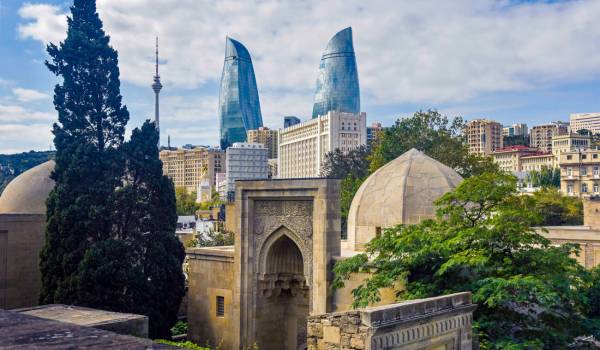
Baku
Located on a steep cliff, Shusha is the cradle of Azerbaijani culture, the ancient city of Azerbaijan, which has been in the spotlight of empires for centuries, known for its unique nightingale flowers and decorated world museums with carpets.
Shusha, one of the most charming parts of Azerbaijan, surrounded by the greatness of the snow-capped mountains that hold Khan Shushinsky's voice in their arms. Shusha, one of the cultural centers of the East, is distinguished by the national architectural style, by the historical figures who gave our culture, literature, and art and considered to be the cradle of our mugam. Shusha, a charming corner of Karabakh, which brought up Gasim bey Zakir, Khurshidbani Natavan, Mir Mohsin Navvab, Najaf bey Vazirov, Abdurrahim bey Hagverdiyev, Yusif Vazir Chamanzaminli, Firudin bey Kocharli, Ahmad bey Agaoglu, is also distinguished by its Oriental architecture. This ancient city, an impregnable fortress of Azerbaijan, is a temple of culture and a historical monument.
Khan and Gakhal caves, Shusha fortress Khurshudbani Natavan, artillery general Mehmandarov's, poet-artist Mir Mohsun Navvab's house museums, Ibrahim khan's and his daughter Gara Boyukkhanim's castles, Ganja gates, Govhar Aga mosque, the main shopping center "Rastabazar", magnificent castle walls and other buildings built in the architectural style fascinated visitors to the city.
As the authors of "Karabakhname" show, in different periods of history, the Shusha fortress, which did not surrender to the khagans, was besieged for months, but no one was able to conquer this heavenly land. The poet Molla Panah Vagif, the vizier of the Karabakh Khan, said, "If the one who protects me is an acquaintance of mine, he will keep the glass safe even inside the stone," adding that Shusha was an impregnable fortress at that time.
"There is no Karabakh without Shusha, and no Azerbaijan at all without Karabakh." National leader Heydar Aliyev expressed the value of Shusha for our country with these words. As President Ilham Aliyev said, Shusha is a dear city, a dear land, a dear fortress, a dear monument not only for the people of Shusha but for all Azerbaijanis, for every citizen who loves his or her homeland and nation.
Before the occupation of Turshsu, Sakili spring, Isa bulagi (spring), Shamil spring, Jydyr plain were favorite places. Turshsu was known as a recreation and treatment area. One of the sights of Shushi was Yukhari Dashalty. The people called this place of rest "Shamil's garden". The peculiarity of this place is that the recreation area is located around the spring, on the Dashalty river, just below the Uchmikh mountain. Mount Uchmikh, located to the west of the Cidir plain, consists of three high hills behind each other. My toponym was named Uchmikh because the hills resembled nails from the outside.
One of the places around the city is the Topkhana forest, which has historical significance and a beautiful climate. During the reign of Karabakh khan Ibrahimkhalil khan, about 50 large and small artillery installations were placed in the area outside the fortress to defend Shusha. That is why the area is called Topkhana. Protests over the deforestation of the Topkhana forest in 1988 sparked a field movement in Azerbaijan. Built at an altitude of 1403 meters above sea level, Turshsu was also famous for its mineral water, and as a resort has become a place where visitors can relax the most.
Shusha, the homeland of the nightingale, has always been a sight to behold because of its beauty. The symbol of the city of Shusha is a nightingale flower that never grows anywhere. After the Second Karabakh-Patriotic War, the flower was accepted as a symbol of martyrdom. The nightingale is a very beautiful decorative flower. In the Azerbaijani language, "khari" means "bee", and "nightingale" means "nightingale", the bird with the most melodic song. If you look closely at the flower, you will see that it looks very much like a bird or a bee.
On May 8, 1992, Shusha with a population of 24,900 people, a charming corner of Azerbaijan, a symbol of the beauty of Karabakh, was occupied by the Armenian armed forces. As a result of the occupation, a number of cultural monuments in Shusha were looted by the enemy, and historical monuments were destroyed.
The city, which had been occupied and looted for 28 years, was liberated by the Azerbaijani Armed Forces on November 10, 2020, and regained its freedom.
In order to erase the historical traces of Azerbaijanis as a result of the occupation of Shusha, vandals destroyed about 600 historical and architectural monuments, including Panahali Khan's palace, Yukhari Govhar Agha Mosque, Ashagi Govhar Agha Mosque, Khurshidbanu Natavan's house, Mullah Panah Vagif's mausoleum and dozens of museums, plundered and destroyed the rare pearls of art here.